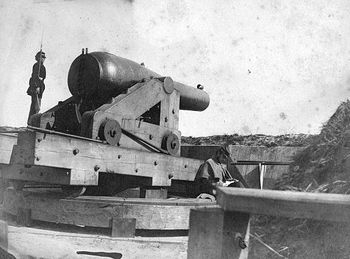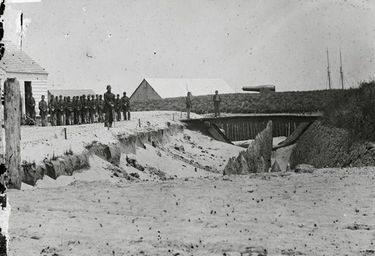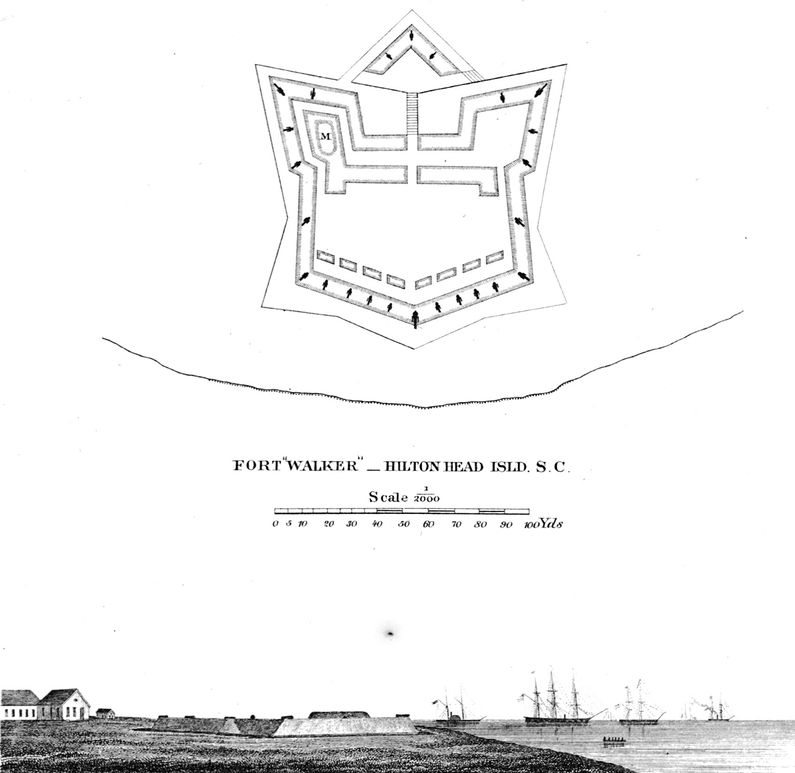Fort Welles
|
Fort Welles (1861-1865, 1897-1902) - A U.S. Civil War Coastal Fort on Hilton Head Island, Beaufort County, South Carolina. First established as Fort Walker in May 1861 by Confederate forces and named for Confederate Secretary of War, LeRoy Pope Walker. Captured by invading Union forces on 7 Nov 1861. Renamed as Fort Welles in G.O. 29, Headquarters, Expeditionary Corps, Hilton Head, South Carolina, 15 Nov 1861 after the U.S. Secretary of the Navy, Gideon Welles. Abandoned as fortification in 1865.
U.S. Civil War (1861-1865)Part of the Civil War Defenses of Hilton Head. Fort Walker (1861)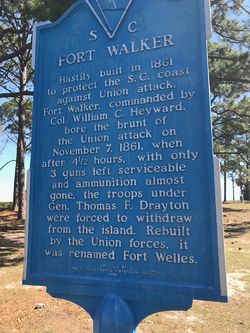 Initially built in 1861 as Fort Walker, a Confederate earthworks fortification, with 16 guns, on the strategic entrance to Port Royal Sound in South Carolina. Fort Walker and Fort Beauregard on the other side of the entrance to the sound were attacked and overwhelmed by a large Union fleet of over fifty ships on 7 Nov 1861. Work on the fort had begun in July 1861 using slave labor provided by island planters. Construction continued through the summer with the slaves hauling palmetto logs, digging trenches, erecting a powder magazine, and constructing gun emplacements. Confederate Major Francis D. Lee was in charge of planning and constructing the defenses while Colonel John A. Wegener was in charge of the fort with 220 men of the First Artillery, South Carolina Militia. Later reinforcements brought the total defender complement to about 1,450 men (inside and outside the fort). The fort was incomplete at the time of the attack and did not have its complete complement of guns mounted.
The Battle of Port Royal Sound At 9:26 am on 7 Nov 1861 a Confederate gun at Fort Walker fired a shot at the head of the Union column of ships and the battle began. It did not last long. The Union line of gunboats circled in an oval pattern in the channel between Fort Walker and Fort Beauregard and poured continuous fire into both until the gun crews sought refuge in the bombproofs and the gun positions were reduced. About 2 pm, after the Union fleet had completed the fifth pass at the fort, the Confederate defenders decided to evacuate. Union Commander John Rodgers, came ashore with a flag of truce and finding no resistance he hoisted the Union colors. The initial landing party of U.S. Marines was followed by the landing of 13,000 Union troops under General Thomas W. Sherman who secured the Island. Further reading
Fort Welles (1861-1865) Union forces occupied the fort for the remainder of the war and significantly expanded it into a system of earthworks almost two miles long. The name of the fort itself was changed to Fort Welles and it was surrounded by a major logistics base that would come to house some 40,000 troops. A major reason for the capture of Hilton Head was to provide a logistics base to support the blockade of southern ports. Since Hilton Head had a deep water harbor potential the Union established a long pier adjacent to Fort Welles and fitted it out with a rail system to offload supplies from cargo ships coming from the North and then to load blockading vessels with supplies. This activity continued for the duration of the war. Located behind the supply depot was an area known as "Robber's Roost" that catered to the needs of camped troops and the fort garrison with goods and services not supplied by the military. 
Slavery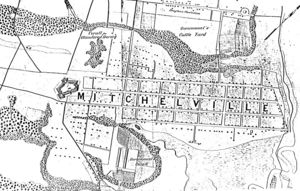 As the war progressed the U.S. military was forced to address the issue of slavery and in particular the issue of what to do with runaway slaves who turned up at U.S. Military Installations. In the beginning, runaway slaves were turned away or returned to their owners. At Hilton Head, the numbers of escapees grew and the options for dealing with them were very limited. Major General Ormsby M. Mitchel, Commander of the Department of the South, headquartered at Hilton Head, establish a town for the escaped slaves, known then as "contrabands". He built a town that became known as Mitchelville near the military reservation. Mitchelville was developed as a regular town, with roads, quarter-acre lots, some elected officials, a church, and a system of laws. The benefits to the runaways and the military were positive in that the runaways had a stable environment and the military had a stable workforce. To protect Mitchelville from marauding Confederate units Fort Howell was built to guard the roads coming into the town.
ClosureAt the close of the war in 1865 Fort Welles was deactivated as a fortification and in April 1866, the Post of Hilton Head was established to include most of the military facilities left on Hilton Head Island. On 14 Jan 1868, the Post of Hilton Head was abandoned and the military left the Island. Endicott Period (1890-1910)In 1897 Congress appropriated monies for the purchase of additional experimental compressed air Dynamite guns for emplacement at four coastal fortifications. Hilton Head was chosen to have a single gun emplaced and a concrete battery was about built 310 yards north of Fort Welles. Battery Dynamite (2) was tested and inspected during 1901-1902 but was deactivated and scrapped when the experimental program was discontinued. Current Status A small park is identified as the site of Fort Walker/Fort Welles near the intersection of Fort Walker Drive and North Port Royal Drive on Hilton Head Island, Beaufort County, South Carolina. There are few visible remains of the of the actual fort but there are markers and some interpretive panels. Accessible to non-residents of the gated Hilton Head Plantation community by a guided tour through the Coastal Discovery Museum (Wednesdays at 10 am). Reservations can be made online or by phone. The tour departs from the golf course just outside the gate.
See Also: Sources:
Visited: 7 Mar 2018
| ||||||
